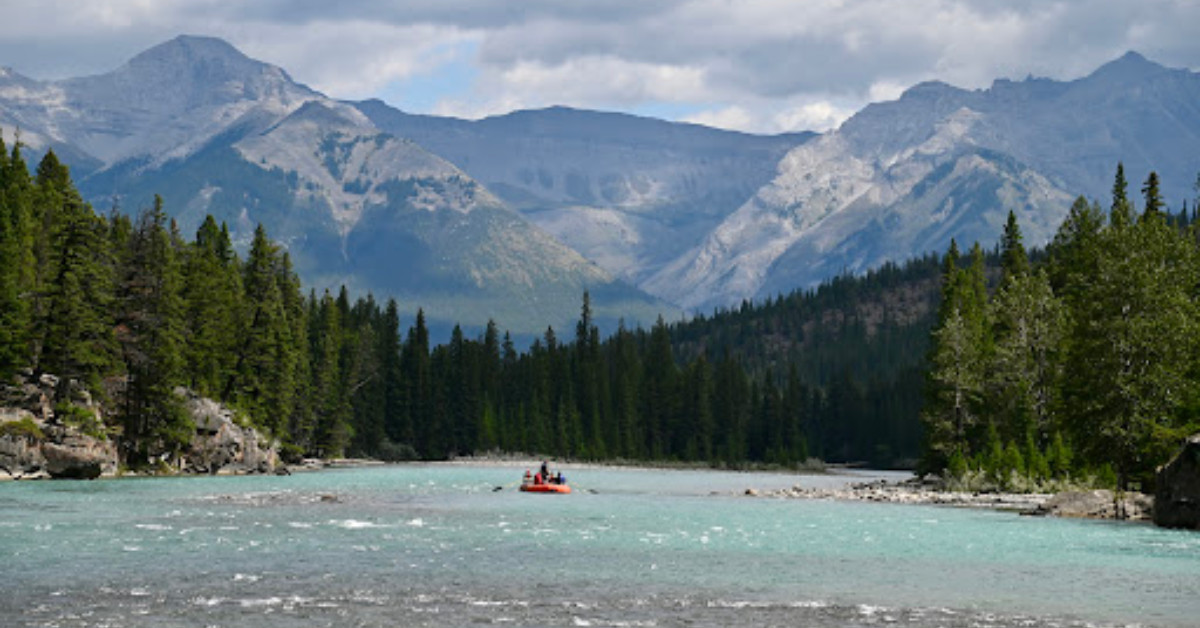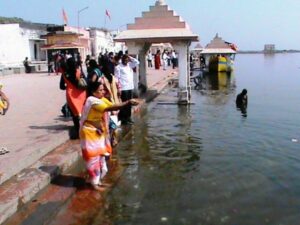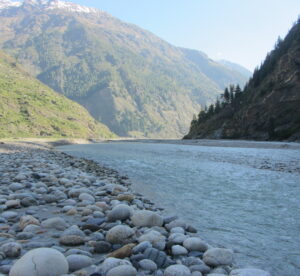 Ganga is given the status of mother in Hinduism. Ganga is considered to be the holiest river of Hinduism. Ganga has been a symbol of divinity, spirituality, purity and salvation. The Ganges River takes shape in Uttarakhand. In Uttarakhand, the Ganges flows in the form of small streams, rivers and their tributaries at many places.
Ganga is given the status of mother in Hinduism. Ganga is considered to be the holiest river of Hinduism. Ganga has been a symbol of divinity, spirituality, purity and salvation. The Ganges River takes shape in Uttarakhand. In Uttarakhand, the Ganges flows in the form of small streams, rivers and their tributaries at many places.
The Ganges River flows 2,525 kilometers (1,569 mi) from the Himalaya Mountains into the Bay of Bengal in northern India and Bangladesh. The Ganges flows through Indian territory for most of its flow, although its large delta in the Bengal region, which it shares with the Brahmaputra River, is mostly located in Bangladesh.
The estuary of the Ganges River forms the world’s largest delta, known as the Sundarbans Delta, which covers over 105,000 square kilometers (41,000 sq mi). It was declared a World Heritage Site by UNESCO in 1997.
story of origin of mother ganga:
Bhagirathi, rises from the bottom of Gangotri Glacier at Gomukh in Devbhoomi Uttarakhand. Which is at an altitude of 4,356 meters. Which is 15 kilometers away from Gangotri Dham, one of the four Dhams. Which is mythologically believed to be the abode of the tangled hair of Shiva. About 5 km away from it is Tapovan, a meadow of supernatural beauty at the feet of the Shivalinga mountain.
Ganga is given the status of mother in Hinduism. Ganga is known as Bhagirathi from Gaumukh to Devprayag. Later it comes in its original form after meeting Mandakini, from where it is known as Ganga.
The story of the origin of Maa Ganga is told in mythology, that the ancestors of King Bhagiratha were consumed by Kapil  Muni’s curse. For their peace, the king wanted to bring the mother ganga to earth.
Muni’s curse. For their peace, the king wanted to bring the mother ganga to earth.
He worshiped the mother gana, mother Ganga was pleased with her rigorous penance. And agreed to come to earth, she said who would stop her swift flow on earth. If she is not stopped, she will go to Hades, breaking the planes of the earth. When King Bhagiratha asked for the remedy, Mother Ganga said that only Lord Shiva could stop their fierce stream. If she agrees to stop the stream on her head, Mother Ganga can come down to earth.
King Bhagirath worshiped Lord Shiva. Lord Shiva was pleased with her worship and agreed to hold Maa Ganga in his hair. At the request of King Bhagirath, Lord Shiva squeezed a hair and spilled the water of the Ganges on the earth. Ganga Mata was named Jatashankari because of Shiva’s hair coming out.
Ganga:
The Bhagirathi originates from the bottom of t he Gangotri Glacier at Gomukh. Which is at an altitude of 4,356 meters, which is mythologically believed to be the abode of the tangled hair of Shiva. About 5 km away from it is Tapovan, which is a meadow of supernatural beauty at the feet of the Shivalinga mountain.
he Gangotri Glacier at Gomukh. Which is at an altitude of 4,356 meters, which is mythologically believed to be the abode of the tangled hair of Shiva. About 5 km away from it is Tapovan, which is a meadow of supernatural beauty at the feet of the Shivalinga mountain.
The six longest tributaries of the Ganges and their five confluence sites are considered the most sacred. Alaknanda, Dhauliganga, Nandakini, Pindar, Mandakini and Bhagirathi are the six major streams of the Ganges. Their confluences, which are known as Panch Prayag, Vishnuprayag, Nandprayag, Karnprayag, Rudraprayag, Devprayag. The river Ganga comes in its original form from the confluence of the Bhagirathi and Alaknanda rivers in the city of Devprayag.
After flowing for 256.90 km through a narrow Himalayan valley, the Ganges rises from the mountains at Rishikesh, and descends on the Ganges plain at the pilgrimage city of Haridwar.
About Ganga:
The Ganges basin covers an area of 1 million square kilometers (386,000 sq mi). It has the largest population of any river basin in the world. It includes more than 400 million people.
The Ganges and its tributaries provide a year-round source of irrigation to a large area. The main crops grown in this region are rice, sugarcane, pulses, oilseeds, potatoes and wheat etc.
The Ganges basin supports many diverse ecosystems, from alpine forests near Gaumukh to mangrove forests in the plains of North India and the saline clay flats of West Bengal.
Seagulls, myna birds, parrots, crows, kites, partridges and chickens are found in many varieties of birds around the Ganges. In winter, ducks and snipes migrate south to the higher Himalayas, settling in areas covered by water in large numbers.
Ganga is the third largest river in the world by discharge. It is the 34th longest river in the world by length. The average depth of the Ganges River is 16 meters (52 ft) and the maximum depth is 30 meters (100 ft).
The major rivers of Ganga are Ramganga, Gomti, Ghaghara, Gandaki, Budhi Gandak, Koshi, Mahananda, Tamsa, Yamuna, Son and Punpun.
The Ganges and its tributaries provide a year-round source of irrigation over a large area. The main crops grown in the region include rice, sugarcane, pulses, oilseeds, potatoes and wheat.
River Ganges is of utmost importance to the people of India as most of the people living along its banks use it for daily needs such as bathing and fishing.
Pollution threatens not only humans, but also more than 140 fish species, 90 amphibian species.
The Ganges is also home to freshwater dolphins and the Ganges shark, both of which are endangered species with the Ganges shark being critically endangered.
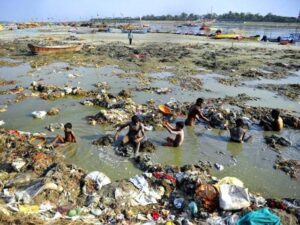 In 2007 the Ganges was ranked as the fifth most polluted river in the world.
In 2007 the Ganges was ranked as the fifth most polluted river in the world.
The banks of the Ganges and its tributaries are home to countless archeological sites, national heritage sites and world heritage sites such as the Nanda Devi Wildlife Sanctuary, the Valley of Flowers National Park and the Taj Mahal, one of the Seven Wonders of the World.
Bathing in the Ganges was and is an important part of Hindu pilgrimage and cremated ashes are often spread in its waters.
Cities on the banks of the Ganges:
The Ganges River flows through 29 cities with a population of more than 100,000, 23 cities with a population between 50,000 and 100,000, and approximately 48 cities. These cities include Rishikesh, Haridwar, Varanasi, Allahabad and Kolkata etc.
Rishikesh:
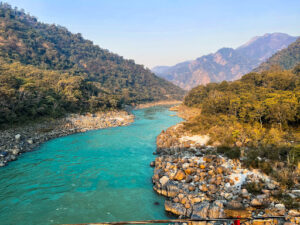 Rishikesh is a tehsil of Dehradun, Uttarakhand. It is located in the foothills of the Himalayas in northern India, known as the “Gateway to the Garhwal Himalayas”. Rishikesh is the initial phase of flights to the Char Dham Yatra destinations – Gangotri, Yamunotri, Badrinath and Kedarnath. Rishikesh is also known for Ayurvedic medicines. Many Ayurveda centers run where Ayurvedic classes are given by Ayurvedic experts.
Rishikesh is a tehsil of Dehradun, Uttarakhand. It is located in the foothills of the Himalayas in northern India, known as the “Gateway to the Garhwal Himalayas”. Rishikesh is the initial phase of flights to the Char Dham Yatra destinations – Gangotri, Yamunotri, Badrinath and Kedarnath. Rishikesh is also known for Ayurvedic medicines. Many Ayurveda centers run where Ayurvedic classes are given by Ayurvedic experts.
Travelers from all over the world come to Rishikesh for travel, yoga and rafting, making Rishikesh a global attraction.
Rishikesh is considered a holy city by Hindus and is vegetarian by law. Meat and alcohol are not served inside the city. Cows roam freely on the roads and if they stop the movement then surely they get good luck on the way.
Haridwar:
Haridwar is also called the city of pilgrimages. The river Gang es reaches here after flowing 253 km from the Gangotri Glacier. A large number of devotees, pilgrims and tourists gather at Haridwar to take a ceremonial bath on the banks of the Ganges waterway at the Kumbh Mela.
es reaches here after flowing 253 km from the Gangotri Glacier. A large number of devotees, pilgrims and tourists gather at Haridwar to take a ceremonial bath on the banks of the Ganges waterway at the Kumbh Mela.
Kanpur:
 The city of Kanpur was called the Manchester of the East. It is a city situated on the banks of two of the most important and holiest rivers of India in the Puranas, the Ganges in the east and the Yamuna in the south.
The city of Kanpur was called the Manchester of the East. It is a city situated on the banks of two of the most important and holiest rivers of India in the Puranas, the Ganges in the east and the Yamuna in the south.
Allahabad:
Allahab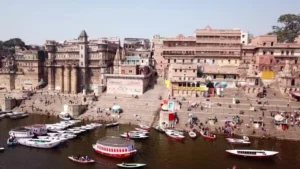 ad city is in Uttar Pradesh. The unique name of the city – Prayag has its origin from the confluence of the Ganges, Yamuna and Saraswati rivers.
ad city is in Uttar Pradesh. The unique name of the city – Prayag has its origin from the confluence of the Ganges, Yamuna and Saraswati rivers.
It is the second most established city in India, and plays a major role in Hindu holy cities. Allahabad has facilitated both sporting and cultural occasions, including the most popular Kumbh Mela and Indira Marathon.
Varanasi:
 Varanasi, also known as Banaras or Kashi, is a North Indian city located on the banks of the Ganges River in Uttar Pradesh. It is the holiest of the 7 sacred urban areas (Sapta Puri) in Hinduism and Jainism, and played an important role in the advancement of Buddhism. Hindus believe that passing through Varanasi leads to salvation. It is one of the most consistently established cities. The culture of the city of Varanasi is closely related to the river Ganges. The city has been a social center of North India for nearly 1000 years, and a history that is more established than that of real world religions. One of the largest universities in Asia, Banaras Hindu University (BHU), is in Varanasi. Varanasi has been selected by the Government of India as one of the heritage cities for HRIDAY.
Varanasi, also known as Banaras or Kashi, is a North Indian city located on the banks of the Ganges River in Uttar Pradesh. It is the holiest of the 7 sacred urban areas (Sapta Puri) in Hinduism and Jainism, and played an important role in the advancement of Buddhism. Hindus believe that passing through Varanasi leads to salvation. It is one of the most consistently established cities. The culture of the city of Varanasi is closely related to the river Ganges. The city has been a social center of North India for nearly 1000 years, and a history that is more established than that of real world religions. One of the largest universities in Asia, Banaras Hindu University (BHU), is in Varanasi. Varanasi has been selected by the Government of India as one of the heritage cities for HRIDAY.
mirzapur:
Mirzapur is a city of UP, about 89 km from Allahabad and 57 km from Varanasi. Mirzapur is acclaimed for the holy place of Vindhyachal. It has many waterfalls and distinctive places. This is the place in India where the holy river Ganges meets the Vindhya range. It is considered a giant in Hindu mythology with writings in the Vedas. The Vindhyavasini Devi Temple located here is a notable attraction.
Baliya:
B allia is a city in Uttar Pradesh bordering Bihar. The eastern boundary of the city lies at the crossroads of two notable streams, the Ghaghra and the Ganges. The city is 140 km away from the city of Varanasi. Dadri Fair is the second largest cattle fair in India, held 5 km from Ballia city.
allia is a city in Uttar Pradesh bordering Bihar. The eastern boundary of the city lies at the crossroads of two notable streams, the Ghaghra and the Ganges. The city is 140 km away from the city of Varanasi. Dadri Fair is the second largest cattle fair in India, held 5 km from Ballia city.
Patna:
Patna is the largest city of Bihar. The present city of Patna is on the southern bank of the Ganges. The city is also spread across the Punpun, Son and Gandak streams.
Bhagalpur:
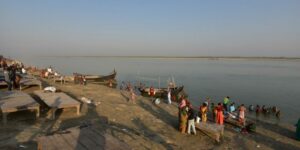 Bhagalpur is a city located on the southern bank of the Ganges in Bihar. Bhagalpur is the second largest city in the state of Bihar after Patna city. It is the major commercial, educational and political center of eastern India.This city is known as “Silk City” in India. The most popular Vikramshila Ganga Dolphin Sanctuary is famous for its Ganges Dolphin.:
Bhagalpur is a city located on the southern bank of the Ganges in Bihar. Bhagalpur is the second largest city in the state of Bihar after Patna city. It is the major commercial, educational and political center of eastern India.This city is known as “Silk City” in India. The most popular Vikramshila Ganga Dolphin Sanctuary is famous for its Ganges Dolphin.:
Kolkata:
Kolkata is t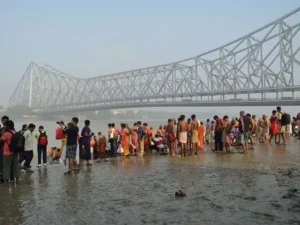 he capital of West Bengal. Situated on the eastern bank of the Hooghly stream, it is the main business, social and educational center of eastern India, while the port of Kolkata is India’s most experienced working port and also its only major port.
he capital of West Bengal. Situated on the eastern bank of the Hooghly stream, it is the main business, social and educational center of eastern India, while the port of Kolkata is India’s most experienced working port and also its only major port.
Mother Ganga:
Ganga is a holy river for Hindus. Throughout their route, Hindus bathe in its waters paying homage to their ancestors.
In Hindu mythology, the local rivers are said to resemble the Ganges and are sometimes referred to as the local Ganges. The Godavari River of Maharashtra in western India is called the Ganges of the South or ‘Dakshin Ganga’; Godavari is the Ganges which was led by sage Gautam to flow through central India. Ganga is also the mother of Hindu worship and culture, Ganga, who accepts all and forgives all. Unlike other deities, they have no destructive or fearsome aspect, although they may be in the form of a river in nature. She is also the mother of other gods.

